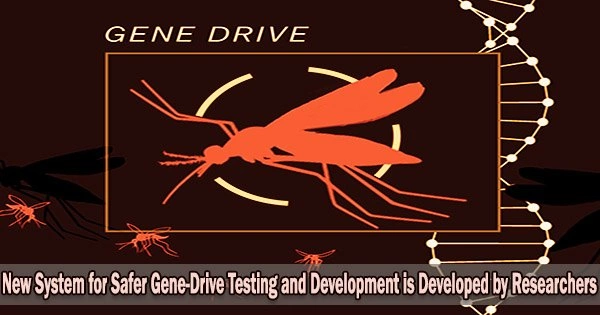A gene drive is a genetic technology that spreads a specific trait through a population by increasing the frequency of that trait in the gene pool. Gene drives have potential applications in controlling or eliminating pest populations, but they also raise concerns about unintended ecological consequences and ethical implications.
The vast potential of CRISPR and its technological frontiers are still being explored by scientists in a variety of fields, from human health to the world’s food supply. CRISPR-based gene drives, a genetic editing technique created to alter how genetic components are transferred from one generation to the next, are an example of this.
Although mosquito-specific gene drives have the potential to stop the spread of malaria infections, which kill hundreds of thousands of people annually, safety concerns have been raised because to how quickly such drives can propagate and take over entire populations.
By experimenting with various combinations of the parts that make up the drive mechanism, scientists have investigated the principles driving the dissemination of gene-drive components in targeted populations such as mosquitoes. They have found, however, that there’s still more to explore and key questions remain.
In the journal Nature Communications, University of California San Diego researchers led by former Postdoctoral Scholar Gerard Terradas together with Postdoctoral Scholar Zhiqian Li and Professor Ethan Bier, in close collaboration with UC Berkeley graduate student Jared Bennett and Associate Professor John Marshall, describe the development of a new system for testing and developing gene drives in the laboratory and safely converting them into tools for potential real-world applications.
“These studies both empower new engineering of gene-drive systems while providing important information regarding how to assess and analyze key interactions between their most important moving parts,” said Bier, a faculty member in the School of Biological Sciences, Department of Cell and Developmental Biology.
CRISPR-based gene drives feature a protein called a Cas9 endonuclease and a guide RNA molecule that join forces to direct DNA cuts to specific sites in the genome where new genetic elements can be inserted.
The additional genetic elements are copied from one chromosome to another as the DNA heals these breaks, leading to offspring that do not inherit equally from both parents, favoring the newly inserted genetic components.
First, and most importantly, the study provides proof-of-principle for the agile genetic conversion of an sGD into an fGD, which should greatly aid in the testing and development of new optimized gene-drive systems.
Gerard Terradas
Gene drives come in two “flavors.” Full gene drives (fGDs) carry both the Cas9 and guide RNA components in a linked unitary package. In contrast, split drives (sGDs) consist of two genetic elements that separately carry the Cas9 and guide RNA components and are inserted at different sites in the genome.
sGDs are considered to be safer than fGDs since it is possible to control and test the components carried by each of the elements separately or under conditions where they gradually amplify the frequency of the gRNA component. In order to deliver the consequences of a complete gene drive, researchers construct the two components to finally reconnect.
Full gene drives have generated a lot of interest in the effort to eradicate malaria because they can be used to transfer components that prevent the spread of infection-causing parasites.
However, because of their potential to spread quickly and perhaps change the genetic make-up of entire mosquito populations, fGDs have also given rise to worries. High-security barriers and limits are needed while working with fGDs to prevent the unintentional escape of insects carrying the drives into the open environment.
This is not the case with split gene drives. Key components being separate reduces the potential of unintended transmission and gives researchers more control over the safe manipulation of sGDs. The ability to conduct sGD experiments in conventional lab settings gives researchers far more flexibility when evaluating their potential.
Scientists have been challenged, however, in developing systems that effectively convert sGDs into fully functioning fGDs. The current conversion of sGD systems into fGDs has difficulties since it depends on two distinct genetic components, each of which must exhibit effective drive qualities.
A versatile genetic “hacking” approach for transforming sGDs into fGDs has now been developed by UC San Diego researchers who have lately made significant contributions to the development of gene drives and related technologies.
The researchers created a unique genetic technique in fruit flies that makes use of a specifically created guide RNA carried by the Cas9 component of the sGD. This hacking tool cuts the copying component of the sGD and triggers a genetic exchange, or “recombination event,” that inserts the Cas9 into the element carrying the guide RNA, resulting in the creation of a fully functioning fGD.
“First, and most importantly, the study provides proof-of-principle for the agile genetic conversion of an sGD into an fGD, which should greatly aid in the testing and development of new optimized gene-drive systems,” said paper first author Terradas, who is now based at Penn State University.
The researchers’ new sGD-to-fGD hacking system enabled them to achieve some unexpected results. As predicted, populations of flies in cage studies were exposed to the newly hacked fGD. However, surprisingly, it spreads at a slower rate than models had anticipated for a conventional fGD.
Bennett and Marshall created a mathematical model that offered an explanation as research partners. Their model showed that fGDs had a higher fitness cost on individual flies during the hacking conversion than sGDs alone. The fitness penalty, which materializes when the drive element replicates itself, disappeared after operating on all population-wide possible target chromosomes.
“The study reveals unanticipated complexities in how gene-drive components work together, revealing that one cannot simply assume how separate components may interact when brought together,” said Bennett.





